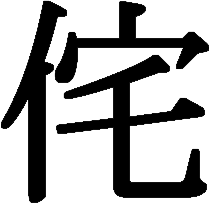WABI
The name of Wabi-Style shop comes from the word ‘wabi’. It is a very important category of the Japanese esthetics, which originated in the medieval Japan and constitutes a very important notion for the Japanese. Below please find the word WABI represented in Kanji characters:
A genuine wabibito, meaning a man who lives according to wabi principles, is a person who strives for simplicity, peace and spiritual freedom in life. Such person sees beauty not in loud and intrusive objects but in objects closely connected with nature. He is able to observe that objects, which seem sad and distant, in reality hide its true energy and fullness of life. By celebrating and expressing respect a true nature of such objects comes to the surface.
Wabi is present in every element of the Japanese art but it is the most visible in the tea ceremony referred to as wabicha (wabi style tea, served in a peaceful atmosphere). The art of brewing tea in a peaceful atmosphere is considered as the greatest manifestation, the essence of wabi. This is where wabi has reached its completeness. On one hand, it is an esthetic concept, which stands for beauty of unpretentious, austere simplicity. On the other hand, it is the ideal of life far from the bustle and luxury, peacefulness, closeness to nature.
The art was originated in Japan from the 15th to 16thcentury and has been preserved in its original form since that day. Attributes used in the Japanese tea ceremony are often characterized by a simple design, their shapes are not completely symmetrical, and their colours and textures seem uncomplicated. This superficial imperfection is transformed into a unique feature. These dishes will amaze everyone who can focus on simplicity and appreciate details. Their charm and refined character will be appreciated by people who can see beauty in irregularities. They may arise a state of serene melancholy and spiritual longing.
The concept of medieval Japanese esthetics assumes that art descends from the heights to everyday life, refined elegance is combined with the spirit of simplicity and vitality. At the same time, its nobility and mysterious character extends over a human sphere of life. Passing time and uncertainty of the moment, though still present in present time, no longer create transitory beauty but rather the ideal of absolute, permanent beauty.
The essence of wabi style stands in opposition to the ideal of beauty in the western cultures, bright and exposed in all its glory. Beauty of the Japanese absolute is hidden deep, in darkness, in clouds, in fog…

A genuine wabibito, meaning a man who lives according to wabi principles, is a person who strives for simplicity, peace and spiritual freedom in life. Such person sees beauty not in loud and intrusive objects but in objects closely connected with nature. He is able to observe that objects, which seem sad and distant, in reality hide its true energy and fullness of life. By celebrating and expressing respect a true nature of such objects comes to the surface.
Wabi is present in every element of the Japanese art but it is the most visible in the tea ceremony referred to as wabicha (wabi style tea, served in a peaceful atmosphere). The art of brewing tea in a peaceful atmosphere is considered as the greatest manifestation, the essence of wabi. This is where wabi has reached its completeness. On one hand, it is an esthetic concept, which stands for beauty of unpretentious, austere simplicity. On the other hand, it is the ideal of life far from the bustle and luxury, peacefulness, closeness to nature.
The art was originated in Japan from the 15th to 16thcentury and has been preserved in its original form since that day. Attributes used in the Japanese tea ceremony are often characterized by a simple design, their shapes are not completely symmetrical, and their colours and textures seem uncomplicated. This superficial imperfection is transformed into a unique feature. These dishes will amaze everyone who can focus on simplicity and appreciate details. Their charm and refined character will be appreciated by people who can see beauty in irregularities. They may arise a state of serene melancholy and spiritual longing.
The concept of medieval Japanese esthetics assumes that art descends from the heights to everyday life, refined elegance is combined with the spirit of simplicity and vitality. At the same time, its nobility and mysterious character extends over a human sphere of life. Passing time and uncertainty of the moment, though still present in present time, no longer create transitory beauty but rather the ideal of absolute, permanent beauty.
The essence of wabi style stands in opposition to the ideal of beauty in the western cultures, bright and exposed in all its glory. Beauty of the Japanese absolute is hidden deep, in darkness, in clouds, in fog…





